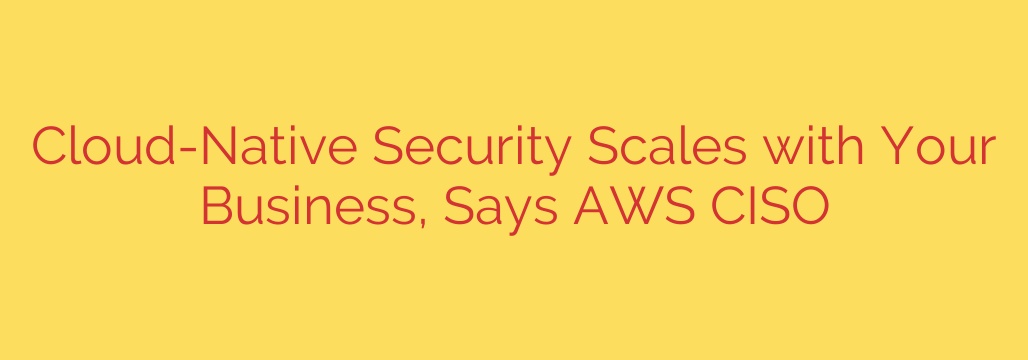
Unlocking Growth with Scalable Cloud Security: A Modern Approach
As your company expands, every system faces a critical test: can it scale? Your sales process, your customer support, and your infrastructure must all adapt to growing demand. But what about your security? For too many businesses, security remains a rigid, reactive function that struggles to keep pace with innovation, creating friction and risk.
The solution lies in shifting from a traditional mindset to a cloud-native security strategy. This isn’t just about moving security tools to the cloud; it’s about fundamentally rethinking how security is integrated into your business. A modern, cloud-native approach ensures that your security posture doesn’t just protect your business—it grows with it.
Why Traditional Security Models Fall Short
For decades, the dominant security model was the “castle and moat.” You built a strong perimeter (a firewall) to keep attackers out. This worked when all your valuable assets were located inside a well-defined network.
In today’s cloud-driven world, that perimeter has dissolved. Your data, applications, and employees are distributed across various cloud services, devices, and locations. A single “wall” is no longer effective when there are thousands of doors. Relying on this outdated model in a cloud environment is like trying to guard a city with no walls—it’s inefficient and destined to fail.
The Power of Cloud-Native Security: Built for Agility and Scale
Cloud-native security is designed from the ground up for the dynamic, automated, and distributed nature of the cloud. Instead of being a roadblock to development, it becomes an integrated and automated part of the process.
The core advantage is scalability. As you deploy hundreds of new application instances or onboard thousands of new users, a cloud-native security framework scales automatically alongside them. This is achieved through several key principles:
- Automation as a Core Function: Manual security reviews and configurations are impossible at scale. Cloud-native security relies on automating security processes, from configuration checks to threat detection and response. This reduces human error and frees up your security team to focus on high-level strategy instead of repetitive tasks.
- Identity as the New Perimeter: If there’s no physical perimeter, then access control becomes the primary line of defense. In the cloud, every user, service, and application has an identity. Managing these identities and ensuring they only have the minimum permissions necessary to perform their jobs (the principle of least privilege) is paramount.
- Integrating Security into the Lifecycle: This concept, often called DevSecOps, involves “shifting left” to build security into the development pipeline from the very beginning. Security checks are automated within the CI/CD (Continuous Integration/Continuous Deployment) pipeline, catching vulnerabilities before they ever reach production.
The Shared Responsibility Model: Know Your Role
A crucial concept in cloud security is the Shared Responsibility Model. It’s a simple but powerful idea that defines the division of security tasks between you (the customer) and the cloud provider (like AWS, Azure, or Google Cloud).
- The Cloud Provider is responsible for the security of the cloud. This includes protecting the physical data centers, the hardware, the networking infrastructure, and the core virtualization services. They ensure the foundation you build on is secure.
- You are responsible for security in the cloud. This includes your data, your applications, your user access policies, and the configuration of the cloud services you use. Misconfiguring a database to be open to the internet, for example, is the customer’s responsibility.
Understanding this division is the first step toward building an effective security program. You can confidently rely on the provider’s massive investment in foundational security while focusing your resources on what matters most: protecting your data and applications.
Actionable Steps for Building Scalable Cloud Security
Transitioning to a scalable security model is a journey, not a destination. Here are practical steps you can take to strengthen your posture:
- Master Identity and Access Management (IAM): This is your most critical control. Implement the principle of least privilege rigorously. Regularly audit permissions and remove any that are no longer needed. Use multi-factor authentication (MFA) everywhere possible.
- Automate Compliance and Configuration Checks: Use cloud-native tools to continuously scan your environment for misconfigurations. Set up automated alerts for issues like public S3 buckets, unrestricted security groups, or overly permissive IAM roles.
- Leverage Managed Security Services: Your cloud provider offers powerful tools for threat detection, logging, and analysis. Utilize these services to gain deep visibility into your environment and detect suspicious activity early, often using machine learning to spot anomalies that a human might miss.
- Embrace Infrastructure as Code (IaC): Define and manage your infrastructure through code (using tools like Terraform or CloudFormation). This allows you to embed security policies directly into your infrastructure templates, ensuring every new environment is deployed securely and consistently.
By adopting these practices, security transforms from a bottleneck into a business accelerator. It becomes a silent, scalable partner that enables your teams to innovate quickly and confidently, knowing that your digital assets are secure no matter how fast your business grows.
Source: https://www.helpnetsecurity.com/2025/08/13/amy-herzog-aws-scale-cloud-native-security/








